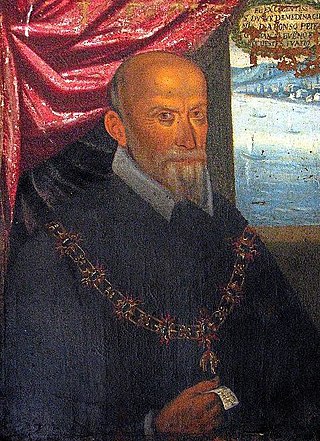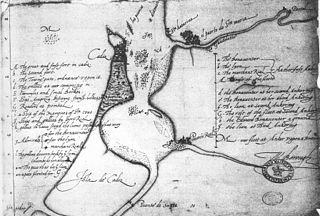
Elizabeth I was Queen of England and Ireland from 17 November 1558 until her death in 1603. She was the last monarch of the House of Tudor.

1588 (MDLXXXVIII) was a leap year starting on Friday of the Gregorian calendar and a leap year starting on Monday of the Julian calendar, the 1588th year of the Common Era (CE) and Anno Domini (AD) designations, the 588th year of the 2nd millennium, the 88th year of the 16th century, and the 9th year of the 1580s decade. As of the start of 1588, the Gregorian calendar was 10 days ahead of the Julian calendar, which remained in localized use until 1923.
The phrase Protestant Wind has been used in more than one context, notably:
- The storm that lashed the Spanish Armada in 1588. The wind wrecked the Spanish fleet and thus saved England from invasion by the army of Philip II of Spain. The English made a commemorative medal saying 'He blew with His winds, and they were scattered'.
- The favourable winds that enabled William of Orange to invade England in 1688, when King James II was deposed in the Glorious Revolution.

Medina Sidonia is a city and municipality in the province of Cádiz in the autonomous community of Andalusia, southern Spain. Considered by some to be the oldest city in Europe, it is used as a military defence location because of its elevation. Locals are known as Asidonenses. The city's name comes from Medina and Sidonia and means "City of Sidon".

Alonso Pérez de Guzmán y de Zúñiga-Sotomayor, 7th Duke of Medina Sidonia, GE, was a Spanish aristocrat who was most noted for his role as commander of the Spanish Armada that was to attack the south of England in 1588. He was a great-great grandson of Ferdinand II of Aragon.

The Anglo-Spanish War (1585–1604) was an intermittent conflict between the Habsburg Kingdom of Spain and the Kingdom of England that was never formally declared. It began with England's military expedition in 1585 to what was then the Spanish Netherlands under the command of Robert Dudley, Earl of Leicester, in support of the Dutch rebellion against Spanish Habsburg rule.

The Spanish Armada was a Spanish fleet that sailed from Lisbon in late May 1588, commanded by Alonso de Guzmán, Duke of Medina Sidonia, an aristocrat without previous naval experience appointed by Philip II of Spain. His orders were to sail up the English Channel, join with the Duke of Parma in Flanders, and escort an invasion force that would land in England and overthrow Elizabeth I. Its purpose was to reinstate Catholicism in England, end support for the Dutch Republic, and prevent attacks by English and Dutch privateers against Spanish interests in the Americas.
The Spanish Armada in Ireland refers to the landfall made upon the coast of Ireland in September 1588 of a large portion of the 130-strong fleet sent by Philip II to invade England.

São Martinho or San Martín, built as a Portuguese Navy galleon, became the flagship of the Duke of Medina Sedonia, the commander-in-chief of the Spanish Armada.
El Gran Grifón was the flagship of the Spanish Armada's supply squadron of Baltic hulks ; see List of Ships of the Spanish Armada. She was shipwrecked on Fair Isle, Shetland, Scotland, on 27 September 1588.

Singeing the King of Spain's Beard is the derisive name given to a series of attacks by the English privateer Francis Drake against the Spanish in the summer of 1587, beginning in April with a raid on Cádiz. This was an attack on the Spanish naval forces assembling in the Bay of Cádiz in preparation for the planned expedition against England. Much of the Spanish fleet was destroyed, and substantial supplies were destroyed or captured. There followed a series of raiding parties against several forts along the Portuguese coast. A Spanish treasure ship, returning from the Indies, was also captured. The damage caused by the English delayed Spanish preparations for the Armada by at least a year. beard

The capture of Cádiz in 1596 was an event during the Anglo-Spanish War, when English and Dutch troops under Robert Devereux, 2nd Earl of Essex, and a large Anglo-Dutch fleet under Charles Howard, 1st Earl of Nottingham, with support from the Dutch United Provinces, raided the Spanish city of Cádiz.
Juan Manuel Pérez de Guzmán y Silva was a Spanish noble and 8th Duke of Medina Sidonia.
The maritime history of England involves events including shipping, ports, navigation, and seamen, as well as marine sciences, exploration, trade, and maritime themes in the arts of England. Until the advent of air transport and the creation of the Channel Tunnel, marine transport was the only way of reaching the rest of Europe from England and for this reason, maritime trade and naval power have always had great importance. Prior to the Acts of Union in 1707, the maritime history of the British Isles was largely dominated by England.

The Sea Dogs were a group of English privateers and explorers authorised by Queen Elizabeth I to raid England's enemies, whether they were formally at war with them or not. Active from 1560 until Elizabeth's death in 1603, the Sea Dogs primarily attacked Spanish targets both on land and at sea, particularly during the Anglo-Spanish War. Members of the Sea Dogs, including Sir John Hawkins and Sir Francis Drake, also engaged in illicit slave trading with Spanish colonies in the Americas.

The 2nd Spanish Armada also known as the Spanish Armada of 1596 was a naval operation that took place during the Anglo–Spanish War. Another invasion of England or Ireland was attempted in the autumn of 1596 by King Philip II of Spain. In an attempt at revenge for the English sack of Cadiz in 1596, Philip immediately ordered a counter strike in the hope of assisting the Irish rebels in rebellion against the English crown. The strategy was to open a new front in the war, forcing English troops away from France and the Netherlands, where they were also fighting.

The 3rd Spanish Armada, also known as the Spanish Armada of 1597, was involved in a major naval event that took place between 18 October and 15 November 1597 as part of the Anglo–Spanish War. The attack of the armada, which was the third attempt by Spain to invade or raid the British Isles during the war, was ordered by King Philip II of Spain in revenge for the English attack on Cadiz following the failure of the 2nd Spanish Armada the previous year due to a storm. The Armada was executed by the Adelantado Martín de Padilla, who was hoping to intercept and destroy the English fleet under Robert Devereux the 2nd Earl of Essex as it returned from the failed Azores expedition. When this was achieved, the Armada would go on to capture either the important port of Falmouth or Milford Haven and use those places as a base for invasion.

The 8th Parliament of Queen Elizabeth I was summoned by Queen Elizabeth I of England on 4 January 1593 and assembled on 19 February following. Edward Coke, the Solicitor-general and Member of Parliament (MP) for Norfolk, was appointed speaker of the commons. At the state opening of Parliament the Lord Keeper Sir John Puckering informed the house that the reasons for summoning the Parliament were the threat of Spanish invasion and the Queen's "extraordinarye and most excessive expenses". This parliament occurred in the context of an ongoing Spanish-English conflict. At the time parliament was called, the Spanish and English were in the midst of ongoing strife that began decades prior and threatened the prosperity of England. Although relations between Spain and England at the start of Elizabeth’s reign began in a largely cordial manner, the two countries came into conflict over their investments in the Americas along with religious differences; Spain was a Catholic nation while England was a largely Protestant nation. Philip II of Spain was in frequent competition with Elizabeth for influence and resources in the New World and sought to weaken England’s sway in the region. In 1582 Philip began preparing a fleet to invade England, the Spanish Armada. Three years later in 1585, Elizabeth and her government feared Philip’s growing power as his empire came “dangerously near to total supremacy in Western Europe,” which threatened the stability of Elizabeth’s rule. By 1588 the Spanish Armada had been successfully prepared for battle and began an invasion of England led by the duke of Medina Sidonia who sailed with 130 ships carrying 29,453 men in total. Their goal: overthrow Elizabeth. Ultimately, the Spanish Armada failed to defeat the British in battle and take Elizabeth’s crown, but it served as a stark reminder to England that the country was not safe from a Spanish threat. This matter of urgency was a major topic of discussion during the 8th Parliament.

Hugo of Montcada i Gralla was the commander of the Galleasses of the Spanish Armada. He was the second son of Francesc I de Montcada, first Marquess of Aitona and Count of Osona, and his wife, Lucrècia Gralla.















